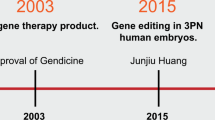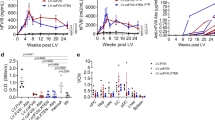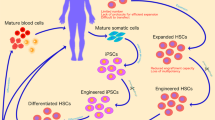Abstract
Recent gene transfer trials for hemophilia A and B, bleeding disorders lacking either functional factor VIII or IX, respectively, have produced tantalizing results, suggesting that the potential to correct these bleeding disorders at a molecular level may be at hand. Genetic correction of the hemophilias represents a model system to develop a basic understanding of how gene therapy will be achieved. The goals for hemophilia gene transfer require the long-term therapeutic production of the coagulant protein without stimulating an immune response to the transgene product or the vector. Based on a scientific understanding of the molecular and cellular defects, leading to the bleeding phenotype, impressive strides have been made in the last 2 years.
This is a preview of subscription content, access via your institution
Access options
Subscribe to this journal
Receive 12 print issues and online access
$259.00 per year
only $21.58 per issue
Buy this article
- Purchase on Springer Link
- Instant access to full article PDF
Prices may be subject to local taxes which are calculated during checkout

Similar content being viewed by others
References
Kaufman R, Antonarakis S . Structure, biology, and genetics of factor VIII, In: Hoffman R, Benz EJ, Shattil S, Furie B, Cohen H, Silberstein L, McGlave P (eds). Hematology: Basic Principles and Practice, Vol. VIII-108, 3rd edn. Church Livingstone: New York, 2000, pp 1850–1868.
Lillicrap D . Hemophilia treatment. Gene therapy, factor VIII antibodies and immune tolerance: hopes and concerns. Haematologica 85 (Suppl 10): 2000.
Monahan P, Samulski R . AAV vectors: is clinical success on the horizon? Gene Therapy 2000;7:24–30.
Chao H et al. Several log increase in therapeutic transgene delivery by distinct adeno-associated viral serotype vectors. Mol Ther 2000;2:619–623.
Chao H et al. Sustained and complete phenotype correction of hemophilia b mice following intramuscular injection of aav1 serotype vectors. Mol Ther 2001;4:217–222.
Gao G et al. Novel adeno-associated viruses from rhesus monkeys as vectors for human gene therapy. Proc Natl Acad Sci USA 2002;99:11854–11859.
Park F, Ohashi K, Kay M . Therapeutic levels of human factor VIII and IX using HIV-1-based lentiviral vectors in mouse liver. Blood 2000;96:1173–1176.
Yant S et al. Somatic integration and long-term transgene expression in normal and haemophilic mice using a DNA transposon system. Nat Genet 2000;25:35–41.
Krebsbach P, Zhang K, Malik A, Kurachi K . Bone marrow stromal cells as a genetic platformfor systemic delivery of therapeutic proteins in vivo: human factor IX model. J Gene Med 2003;5:11–17.
Lin Y et al. Use of blood outgrowth endothelial cells for gene therapy for hemophilia A. Blood 2002;99:457–462.
Chuah M et al. Long-term persistence of human bone marrow stromal cells transduced with factor VIII-retroviral vectors and transient production of therapeutic levels of human factor VIII in nonmyeloablated immunodeficient mice. Hum Gene Ther 2000;11:729–738.
Poon M . Use of recombinant factor VIIa in hereditary bleeding disorders. Curr Opin Hematol 2001;8:312–318.
Chao H, Walsh C . Induction of tolerance to human factor VIII in mice. Blood 2001;97:3311–3312.
Qian J, Collins M, Sharpe A, Hoyer L . Prevention and treatment of factor VIII inhibitors in murine hemophilia A. Blood 2000;95:1324–1329.
Brown B, Lillicrap D . Dangerous liaisons: the role of ‘danger’ signals in the immune response to gene therapy. Blood 2002;100:1133–1140.
Kay M et al. Evidence for gene transfer and expression of factor IX in haemophilia B patients treated with an AAV vector. Nat Genet 2000;24:257–261.
Manno C et al. AAV-mediated factor IX gene transfer to skeletal muscle in patients with severe hemophilia B. Blood, Prepublished online Dec. 19, 2002.
Roth D et al. Nonviral transfer of the gene encoding coagulation factor VIII in patients with severe hemophilia A. N Engl J Med 2001;344:1735–1742.
Wang L et al. Sustained expression of therapeutic level of factor IX in hemophilia B dogs by AAV-mediated gene therapy in liver. Mol Ther 2000;1:154–158.
Nathwani A et al. Sustained high-level expression of human factor IX (hFIX) after liver-targeted delivery of recombinant adeno-associated virus encoding the hFIX gene in rhesus macaques. Blood 2002;100:1662–1669.
Mount J et al. Sustained phenotypic correction of hemophilia B dogs with a factor IX null mutation by liver-directed gene therapy. Blood 2002;99:2670–2676.
Puttaraju M et al. Messenger RNA repair and restoration of protein function by spliceosome-mediated RNA trans-splicing. Mol Ther 2001;4:105–114.
Jiang Y et al. Pluripotency of mesenchymal stem cells derived from adult marrow. Nature 2002;418:41–49.
Author information
Authors and Affiliations
Rights and permissions
About this article
Cite this article
Walsh, C. Gene therapy Progress and Prospects: Gene therapy for the hemophilias. Gene Ther 10, 999–1003 (2003). https://doi.org/10.1038/sj.gt.3302024
Published:
Issue Date:
DOI: https://doi.org/10.1038/sj.gt.3302024
Keywords
This article is cited by
-
Intrathecal Long-Term Gene Expression by Self-Complementary Adeno-Associated Virus type 1 Suitable for Chronic Pain Studies in Rats
Molecular Pain (2006)
-
Design and development of polymers for gene delivery
Nature Reviews Drug Discovery (2005)



